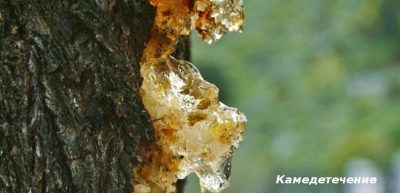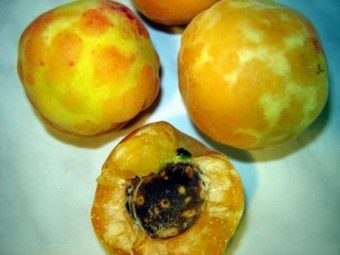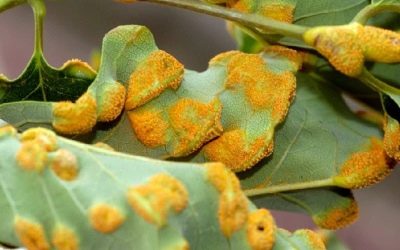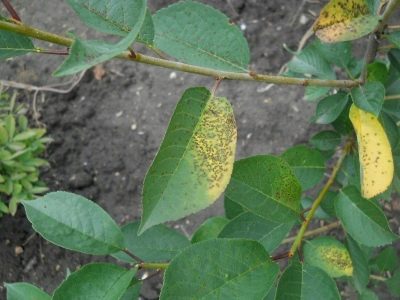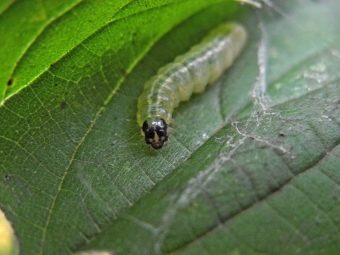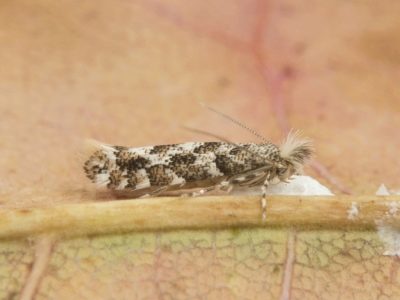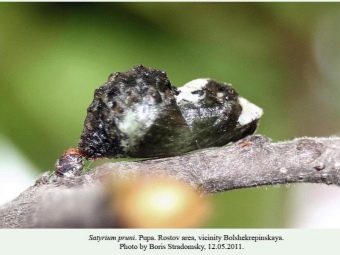How to process plums from diseases and pests?
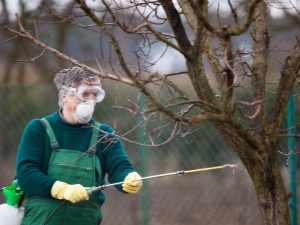
When planting a plum orchard, many novice gardeners have many questions about plum processing, its diseases, ways of pest control and obtaining high quality fruits. It is necessary to figure out how to act if you find the first signs of illness in the “pets”.
Frequent diseases
All fruit trees, including plum trees, are susceptible to various diseases and pest attacks. For a good and generous harvest of this crop you need to be able to recognize the most common diseases in order to competently deal with them. Consider common plum diseases.
Spotting
It is a fungal disease that affects the leaves, causing them to fall off. To protect the plant and prevent the disease from sharpening, it is necessary to get rid of the affected branches.
Milky luster
Defeat fungus that can completely destroy the plant. To avoid this, it is recommended to plant only zoned tree varieties. In the spring, after cutting the branches, new cuts must be patched with garden pitch or oil paint. Reduce the risk of feeding and whitewashing the trunk.
Gray rot
Another such disease is called moniliosis. This is a disease that affects all the elements of plum. The disease begins with damaged fruits and develops further. It occurs at high humidity.
Comedication
It is characterized by viscous flowing droplets on the tree, similar to resin. The main way to avoid illness is to follow all the rules of agricultural technology. The tree must be cut from the old and affected branches. Treating wood with folk remedies and chemicals, as well as adhering to the basic rules of agricultural engineering, will help preserve the culture and reap a good harvest.
Plum pox
Incurable disease, vectors are mites and aphids. As preventive measures, use the timely elimination of marked pests. Damaged parts or wood must be destroyed completely.
Rust
Fungal disease in which the foliage of a tree suffers. It becomes brown in color, as if rusting.
Coccomycosis
This is the formation of red spots on the leaves. Gradually, they turn yellow, curl, and then become brown and fall off.
Dangerous insects
Fruit trees attract many insects that devour fruits and leaves, thereby deteriorating the crop and causing damage to the garden.
Sawfly
This insect has several varieties. Cherry slimy damages almost all fruit trees. The little body of the pest is brilliant, the legs are black, the wings are with dark veins. The size of the female individual is about 6 mm, the male is slightly smaller. Lay up to 70 eggs on the lower shell of the leaf. Infection is determined by the occurrence of brown tubercles on the top of the leaf.
After two weeks, a greenish larva appears, covered with mucus, which saves it from drying out. She eats the flesh of the leaves, and when ripe, falls to the ground and buries 10 cm into the soil. Some turn into pupae, others hibernate and leave it in the next spring. The next generation is born in August and causes even more harm to the plum. The eaten foliage falls, which negatively affects fructification as a whole.
The yellow sawfly has a brown body and glassy wings. The main harm to the plants is caused by the larva of a yellowish - brown color. An adult female can lay up to 60 eggs, of which the caterpillars will hatch in 10 days. They feed on ovaries, after which they crumble and fall.
Black plum sawfly has transparent wings with brown veins, black head and body. The female is able to lay up to 30 eggs. At the stage of origin of the ovary light green caterpillars fall into the plum and eat it from the inside. The berries fall, the caterpillars burrow into the ground for wintering or pupation.
Moth
Moth is of two types: ordinary and American.A common one is a butterfly with wings of a grayish tint, at the back edge of which there is a fringe. Flies out immediately after the tree blooms. A female insect lays up to 50 light green eggs - one per fruit.
First, the caterpillar appears off-white, then changes color to light red. It enters the fetus, covering the wormhole with cobwebs. If the berry is unripe, the larva spoils the bone. In mature it eats up the pulp, damaging the vascular system, and thus stopping the access of beneficial substances to the plum. The fruits begin to rot and fall off. The place of penetration of the pest is given by a hardened drop of gum.
After a month of stay, the insect comes out and hides under the bark of a tree or in the soil. There the caterpillar overwinter or pupate. The American moth has dark brown wings with blue veins and brown spots in front and gray-brown at the back. The caterpillars of this insect eat out the wormholes inside the fruit, which eventually dries and falls, or becomes unsuitable for use in food.
Aphid
Aphids create colonies on the bottom of tree foliage. When the period of plum flowering ends, wingless founders hatch from eggs, from which several subsequent generations originate. Aphid multiplies very quickly and can produce twelve generations of individuals in one season. Eggs spend the winter at the base of the ovaries. This insect is considered the most dangerous for plum trees.
Affected leaves and berries fall. Sugar pest secretions cause the formation of saprophytic fungi, due to the activity of which the shape of the preserved berries is deformed and they rot. It is necessary to fight insects in the spring, until the total reproduction of the parasite has begun.
Coaster
The cobra plum has a black body with transparent wings and paws yellow. A week after the tree blossoms, the female insect, piercing the ovary of the plant, lays one egg in the middle of the stone, which does not yet have hardness. She can lay up to forty eggs, of which after about three weeks the larvae appear. They, penetrating into the core of the bone, wash it into powder. The affected fruits fall off along with the caterpillars inside, which remain there until spring.
Since the insect cannot get out of the stone, the crumbling plums must be collected, and the soil must be deeply dug up. If a large number of fruits are affected, it is worth treating the garden with insecticides at the time of the summer pests.
Zlatoguzka
The goldfinder is a white-winged butterfly with a golden hair pad on its belly. The larva of this insect is greyish-black, with chains of poisonous red warts along the body. Years of insects occur in the middle of summer. Eggs are placed on the lower part of the foliage, branches and trunks, after 2 - 3 weeks the larvae that feed on the pulp of the leaves. They hibernate in branches, shrouded in cobwebs.
Zlatoguzka
Hawthorn is also a butterfly with white wings and dark veins on them. Gray-brown caterpillars have black and brown stripes on the back covered with hairs. Winter is carried out in cocoons of leaves and cobwebs suspended from branches. In one such nest can be up to 70 individuals. Insects revive in early spring and devour the buds, young leaves and flowers.
When the ovaries are formed, the larvae begin to pupate and cling to the branches or trunks with a web. In the middle of summer, the laying of eggs begins on the upper part of the foliage, and after two weeks the larvae crawl out.
Wireworm Mesh
Mesh leafworm - butterfly with wings of yellow-brown outflow with wavy dashed lines in front and rear gray or brownish-red. The larva is dark green with a brownish head. Females can lay up to 180 eggs. Winter spends this pest in the crevices of the bark. It feeds by buds, leaves, flowers and fruits, surrounding them with cobwebs.During the season, two generations of insect grow, which is found everywhere and spoils all pome and stone fruit.
Rose cicada
Pink cicada is a small midge of a light yellow color, very jumping with two pairs of wings. The larvae are yellowish, have three pairs of legs and a pointed abdomen. They overwinter on the branches at the base of the shoots, and appearing in spring, feed on the juice of fresh foliage. By the middle of summer, mature individuals appear from the larvae.
The leaves damaged by the cicadas are of marble color, and the lower parts are covered with whitish-yellow dots. They must be destroyed to prevent the spread of the pest.
Shatter-pan
The sniper is a tiny insect, the females of which have a convex-shaped red-brown body with black lines across the body. In males, the body is longitudinal, covered with a whitish bloom. Caterpillars are oval-shaped with three pairs of legs and antennae, at first pale yellow, and then red-brown. After overwintering adult caterpillars stick to fresh shoots, legs and antennae fall away. After a month, the female individuals expand threefold, and the males turn into small mosquitoes.
In June, males are committed, but females have something like a scab on their backs, where up to 2800 eggs can be placed, from which larvae will hatch in a month. They crawl and stick to the leaves, and at the beginning of autumn they return to the branches for wintering. Dried and infected parts of the plant to be cut and burn, and the tree itself immediately after blooming spray.
Plum moth
The moth plum is a moth of small size, with wings of elongated shape. The larvae are greenish, with a dark brown head, absorb the pulp of the leaves, making miner passages in them. They pupate in a voluminous cocoon in the middle of a mine, which is located on the upper base of the leaf. During the year, two insect generations ripen, in June and September.
Moth-baby
Moth-baby is a tiny butterfly with thin, lined with fringed wings and a hair-covered head. The larvae are amber-yellow, they use leaf parenchyma for food, forming snake-like manholes that expand into a large spot. Harm is applied from June to September.
Moth motley
The motley moth is a small moth with long multi-colored wings, framed by a fringe. Caterpillars of small size, yellow-green, form brown mines at the bottom of the leaf. Damaged foliage is deformed and falls prematurely.
Scoop gamma
The scoop-gamma is a moth with muddy-gray front wings with a silver Y-shaped spot. Green caterpillars with light winding stripes on the back and yellow on the sides, have three pairs of abdominal legs and tall warts with tiny spikes. In total, two insect generations per season are formed.
The years begin in late June, and the second time in August-September. Young larvae gnaw leaves, older individuals eat holes or foliage edges. After 15–20 days of feeding, pupation occurs in cocoons from the web on the eaten sheets. After 7-13 days, new-generation butterflies appear, and newly produced larvae are already wintering in the soil. Scoop-gamma is a very common pest and affects not only fruit trees, but also plants of other families.
Tail
Birch marshmallow or tail - broad-winged moth of a small brown color. On the front wings of the female there is a large orange spot, and in the male there is a tiny gray-yellow speck with a black edging. The rear wings have two yellow-red protrusions and a white rear edge. Larvae are plump, green, with a tiny brown head. There is a double yellow line along the body, and light yellow stripes on the sides.
Years of insects take place in July-August, and the larvae wield on trees in May-June and harm all stone fruit, mainly plums.The tail is found everywhere, but its number is small, it does not cause significant harm.
Redtail
The red-tailed or red-haired garden pile is a rather voluminous butterfly, the females of which have several sinuous dark lines on the front yellowish-gray wings, while the posterior ones are gray with a black stripe and speck. The colors of males are ashy. The hairy larva of yellow, gray or dark brown color has four bunches of long hairs on the back and a pink tail. Overwinter in cobweb shells in the midst of loose leaves, on branches and in trunk cracks.
In the end of May and the beginning of July moths appear, which at night are content with nectar. After summer, the female lays 10 to 100 eggs on the branches. The larvae are covered with long hairs, with the help of which the wind transfers them to neighboring plants. They feed on foliage and are found constantly on fruit tree species.
Weevil
Weevil overwinters in the soil, and comes out before the very flowering of plants, destroying young leaves, flowers and ovaries, or completely eating them. The eggs are laid inside the fetus, the caterpillars that appear gnaw through the bone and feed on the nucleus. A month later, some of them pupate and melt bugs in the fall, and the rest overwinter in the soil.
Wood chip
The wood is a large moth with a thick belly, with an egg-laying at the end, and six round dark green spots on the back. The male is somewhat smaller and has a feathery antennae. On the wings of the insect are blue-green oval markings. Caterpillars are pale yellow with coal-black dots along the entire length of the body. Eggs are laid on branches at the kidneys or in crevices. One female can postpone up to 1000 pieces. The emerged larvae penetrate into the bark and eat wood for two years, laying large curvature in the trunks. This pest causes enormous damage to the garden, provoking numerous death of trees.
Preparations for the treatment and prevention
It is better to spray plum trees from diseases and pests immediately after spring work in the garden so that the wintering larvae do not have time to be born. If you miss the time, you can not count on a good harvest.
It is easy to get rid of such a pest as aphid if you start using protective measures in time. First, you can try to use folk remedies: a strong tincture of tobacco, onion peel, wormwood or garlic with a small amount of soap. These are more preventive methods of protection, and for absolute extermination of the pest it is better to use the preparations Sherpa, Decis, Artelik, Inta-Vir three times a season: before flowering, after it and after the end of fruiting. For the destruction of the eggs of aphids are effective "Nitrafen" and "Olekuprit."
You can fight against the weevil with the help of the Alt and Clean House belts, and karbofos, metaphos or Corsair, Actellic, which are sprayed before and after the color, will be suitable as chemical protection. From the fruit moth bitter pepper tincture works well (500 grams of dry product per bucket of water) with the addition of 40 grams of soap. Spray need twice a month. Of the drugs are effective "Antia", "Nexion", "Methation". From the bark beetle the tree is treated with chlorophos or metaphosis.
For the destruction of sawfly, insecticides such as karbofos, rogor, chlorophos, and kemiphos are used, and from bioadditives, Bitoxibacillin, Lepitocid, Gaupsin, Entobakterin. Tincture of tobacco and bitter wormwood have proven themselves in pest control. The appearance of worms in the fruit can be avoided if, at the first traces of the appearance of caterpillars, the processing of plums with the “Decis”, “Spark” or “Kinmiks” chemical preparations begins. Sprinkling must be done three times, every 15 days.
It is necessary to get rid of wormy fruits as they are carriers of parasites.These insecticidal preparations are effective against virtually all pests of plum trees.
Apply them according to the instructions on the package. Fungal diseases are treated with fungicides: solutions of copper sulphate or Bordeaux mixture, as well as the preparation Nitrafen.
When is it better to spray?
Spraying plum occurs in several stages, the trees must be processed in spring and autumn. Spring garden processing begins even before the movement of the juice, the plants are sprinkled from aphids and weevils. When the first leaves appear, sprinkling is carried out against the occurrence of diseases and pests. The procedure is done several times during and after flowering, as well as all similar activities are carried out in the autumn period. To protect the plum trees include:
- purification of dead bark;
- digging up soil around trees in autumn;
- during the period of egg laying, the release of trichograms that feed them;
- the use of pheromone traps;
- systematic cutting of shoots;
- constant collection of fallen fruits;
- use of insecticides in the processing of the garden;
- carrying out whitewashing of plants;
- disinfecting injuries with a one percent solution of copper sulphate;
- use of garden warrior for bark damage.
If you do not be lazy and follow the rules of agricultural engineering, you can grow a beautiful healthy plum orchard.
For details on how to handle plum from pests, see the following video.




